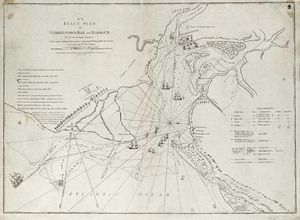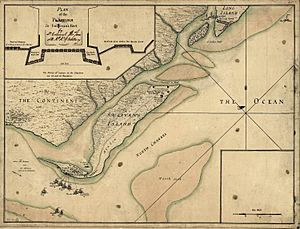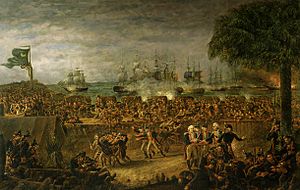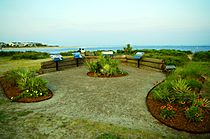Battle of Sullivan's Island facts for kids
Quick facts for kids Battle of Sullivan's Island |
|||||||
|---|---|---|---|---|---|---|---|
| Part of the American Revolutionary War | |||||||
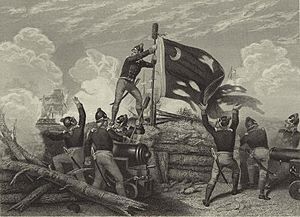 Sergeant William Jasper raising the flag over the fort, painted by Johannes Adam Simon Oertel, 1858 |
|||||||
|
|||||||
| Belligerents | |||||||
| Commanders and leaders | |||||||
| Charles Lee William Moultrie |
Peter Parker (WIA) Henry Clinton |
||||||
| Strength | |||||||
| Fort Sullivan: 435 militia 31 cannons Other defences: 3 shore batteries 6,000+ regulars and militia |
2,200 infantry 2 fourth-rates 6 frigates 1 bomb vessel |
||||||
| Casualties and losses | |||||||
| 12 killed 25 wounded |
220 killed and wounded 2 fourth-rates severely damaged 2 frigates moderately damaged 1 frigate grounded, later scuttled |
||||||
The Battle of Sullivan's Island was a big fight during the American Revolutionary War. It happened on June 28, 1776, near Charleston, South Carolina. This was the first time the British tried to capture Charleston from the Americans. Sometimes, people call it the first siege of Charleston. The Americans won this battle, which was a huge boost to their spirits!
Why Was Charleston Important?
When the American Revolutionary War started in 1775, Charleston was a very important city. It was a major center for trade in the southern colonies. People in Charleston were upset about British taxes, just like other colonists. They started forming militia groups to prepare for war.
Throughout 1775 and 1776, more and more militia members came to the city. Local businesses began making supplies for the war. People also started building defenses around Charleston to protect it.
British Plans for the South
The British army was busy fighting in the northern colonies, especially around Boston. They wanted to find new bases in the southern colonies. So, they planned a big trip south.
General Henry Clinton was supposed to go to Cape Fear, North Carolina. There, he would meet with Loyalists (colonists who supported the British). He would also join 2,000 soldiers coming from Ireland led by General Charles Cornwallis.
This plan had many problems from the start. The ships from Ireland were very late. They were supposed to leave in December 1775 but didn't sail until February 1776. Admiral Sir Peter Parker led these 11 warships.
Clinton left Boston in January. He stopped in New York City and talked with the royal governor. General Charles Lee, an American general, was also in New York. He noticed Clinton was openly talking about his plans to go south. This was strange, as it gave the Americans a heads-up!
Clinton arrived at Cape Fear in March. He learned that the Loyalists he expected had already been defeated. Parker's fleet had a very rough journey. Storms battered the ships, and they arrived late. After weeks of raiding Patriot homes, Clinton, Cornwallis, and Parker decided Cape Fear was not a good base. They heard that Charleston's defenses were not yet finished. So, they decided to attack Charleston instead.
American Defenses in Charleston
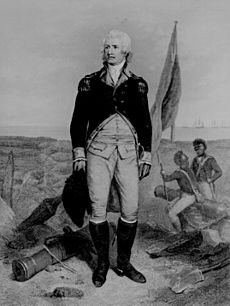
John Rutledge, who led South Carolina's revolutionary government, put Colonel William Moultrie in charge of the defenses. Moultrie was 46 years old and had fought in the militia and against Indians.
His forces included about 2,000 soldiers. More troops arrived from North Carolina and Virginia (1,900 men). Plus, 2,700 militia members from Charleston joined them.
Moultrie thought Sullivan's Island was a great spot for a fort. This sandy island was at the entrance to Charleston Harbor. Any large ship sailing into Charleston had to pass by the southern end of Sullivan's Island.
In March 1776, Moultrie and his soldiers began building a fort there. They used palmetto logs, which are very strong. The fort was built to protect the island and the channel into the harbor. Building the fort was slow work. One officer described it as "an immense pen 500 feet long, and 16 feet wide, filled with sand to stop the shot."
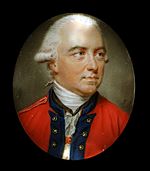
General Lee was sent by George Washington to command the American troops in the South. He arrived in Charleston just after the British fleet. Lee found a problem: the South Carolina troops were not officially under his command. Rutledge had to step in and make Lee the commander of all South Carolina forces.
Fort Sullivan was square-shaped. Only its seaward wall was finished. The walls were 20 feet (6 meters) high and 16 feet (5 meters) wide. They were filled with sand, which made them very strong. The fort had 31 cannons of different sizes.
General Lee saw the fort was unfinished and thought it was a "slaughter pen." He suggested abandoning it. But President Rutledge refused. He told Colonel Moultrie to "obey [Lee] in everything, except in leaving Fort Sullivan." Moultrie stayed, and the battle began before Lee could replace him.
British Arrive
The British fleet left Cape Fear on May 31 and arrived outside Charleston Harbor the next day. Moultrie saw a British boat scouting Long Island, which was close to Sullivan's Island. So, American troops were sent to the northern end of Sullivan's.
By June 8, most of the British fleet was anchored near the harbor entrance. Admiral Parker was sure his warships could easily break the fort's walls. He even thought he wouldn't need Clinton's soldiers.
The British fleet had nine warships, including two large 50-gun ships, HMS Bristol and HMS Experiment. There were also six frigates and a bomb vessel called HMS Thunder. In total, they had almost 300 cannons. Clinton's army had about 2,200 soldiers.
On June 7, Clinton told the colonists to give up. But the Americans fired on the boat carrying his message. The message was finally delivered the next day. That same day, Clinton began landing his troops on Long Island. The plan was for these soldiers to wade across the channel between Long Island and Sullivan's Island. The British thought the water was shallow enough. Meanwhile, the fleet would bombard Fort Sullivan.
General Lee quickly reacted to the British landing. He strengthened positions on the mainland in case the British attacked Charleston directly. He also tried to build a bridge of boats for the fort's soldiers to retreat, but it didn't work. The Americans also built defenses at the northern end of Sullivan's Island. More than 750 men and three small cannons guarded this spot.
General Clinton faced a big problem on June 17. His soldiers tried to wade across the channel, but the water was too deep. It was at least shoulder-deep, too deep to cross while being shot at. He thought about using boats, but the Americans had strong defenses there. Clinton said this meant Admiral Parker would "have the glory of being defeated alone." The attack was supposed to happen on June 24, but bad weather delayed it for several days.
The Battle Begins
On the morning of June 28, Colonel Moultrie and his 435 men defended Fort Sullivan. Around 9:00 AM, a British ship fired a signal gun, meaning they were ready to attack. Less than an hour later, nine warships sailed into position facing the fort.
HMS Thunder and HMS Friendship anchored about 1.5 miles (2.4 km) away. Admiral Parker brought HMS Active, HMS Bristol, HMS Experiment, and HMS Solebay closer, about 400 yards (365 meters) from Sullivan's Island. They anchored with their sides facing the fort.
Each ship started firing as it got into position, and the Americans fired back. Many of Thunders shots landed near the fort but did little damage. Moultrie said, "We had a morass in the middle, that swallowed them up instantly." The fort's sandy walls also absorbed the cannonballs. Thunders role was short. It was too far away, and its mortars broke from being overloaded.
Because they had little gunpowder, Moultrie's men fired slowly and carefully. Only a few officers aimed the cannons. They fired in small groups, four cannons at a time. A British observer wrote, "Their fire was surprisingly well served" and was "slow, but decisive indeed."
General Clinton tried to cross to the northern end of Sullivan's Island. His boats, carrying troops, came under heavy fire from Colonel William Thomson's defenses. Facing a storm of grape shot and rifle fire, Clinton gave up the attempt.
Around noon, three frigates—HMS Sphinx, HMS Syren, and HMS Actaeon—tried to sail around to a different position. They wanted to fire along the fort's main wall and block escape routes. However, all three ships got stuck on an uncharted sandbar. HMS Actaeon and HMS Sphinx even got tangled together. The British managed to free Sphinx and Syren, but Actaeon stayed stuck. This was very lucky for the Americans! Moultrie said, "Had these three ships effected their purpose, they would have enfiladed us in such a manner, as to have driven us from our guns."
Inside the fort, Moultrie told his men to focus their fire on the two large ships, Bristol and Experiment. These ships were hit many times. Chain shot fired at Bristol destroyed much of its rigging and damaged its masts. One shot hit Parker, slightly wounding him.
By mid-afternoon, the Americans were running low on gunpowder. Their firing stopped for a short time. But General Lee sent more ammunition from the mainland, and the defenders started firing again. Lee even visited the fort briefly, telling Moultrie, "I see you are doing very well here, you have no occasion for me."
Admiral Parker tried to destroy the fort's walls with constant cannon fire. But this didn't work because the palmetto wood was spongy. It absorbed the cannonballs instead of breaking apart. The battle continued until about 9:00 PM, when darkness stopped the fighting. The British fleet finally pulled back.
During the battle, the flag Moultrie had designed was shot down. Sergeant William Jasper famously ran to the wall and raised the flag again. He held it up, encouraging the troops, until a new flag stand could be found. Moultrie said Jasper's actions boosted the soldiers' spirits. Jasper was later praised for his bravery.
Parker reported that 40 sailors were killed and 71 wounded on Bristol. The ship was hit over 70 times. Experiment was also badly damaged, with 23 sailors killed and 56 wounded. Active and Solebay each had 15 casualties. The Americans reported only 12 killed and 25 wounded.
The next morning, the British couldn't get the grounded Actaeon off the sandbar. They set fire to the ship to stop it from falling into American hands. American Patriots in small boats sailed to the burning ship. They fired cannons at the British ships, took what supplies they could, and left just before the ship's powder magazine exploded.
What Happened Next?
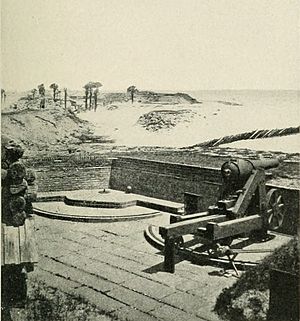
The British did not try to take the fort again. Days after the battle, people in Charleston learned that the Declaration of Independence had been signed in Philadelphia. The British soldiers got back on their ships. On July 21, the British fleet sailed north to help the main British army fight in New York City. To make things worse for the British, one of their transport ships got stuck off Long Island and was captured by the Americans.
The British did not return to Charleston until 1780. That's when General Clinton successfully captured the city and an entire American army. Until the war focused on the South again in late 1778, the southern states sent military supplies north. They also produced goods that brought in money to help fund the war.
After the battle, Admiral Parker and General Clinton blamed each other for the failure. The government didn't blame Clinton, but many people thought he was responsible. Parker was praised for his courage during the fight.
Lasting Impact
Fort Sullivan was renamed Fort Moultrie soon after the battle. This honored Colonel William Moultrie for successfully defending the fort and Charleston. The fort was changed a lot over the years. Before the American Civil War, Fort Sumter became the main defense for Charleston. In 1960, the site became part of Fort Sumter National Monument.
A small monument to the Battle of Sullivan's Island is at the northeastern tip of the island. It looks over the inlet where Clinton's soldiers hoped to cross. The monument has historical markers explaining the events of the battle.
One famous symbol from the battle is the flag designed by Colonel Moultrie. It was a blue flag with a white crescent moon in the top left corner. This flag flew at the fort during the battle. Even though it was shot down, it became a symbol of this important victory. It's now known as the Moultrie flag or Liberty Flag. When Charleston was taken back by American forces at the end of the war, General Nathanael Greene returned the flag to the city.
Every year, starting on the first anniversary in 1777, Charlestonians celebrate "Carolina Day". This day remembers the first major American victory over the British. Local events include a parade in downtown Charleston and reenactments at Fort Moultrie.


